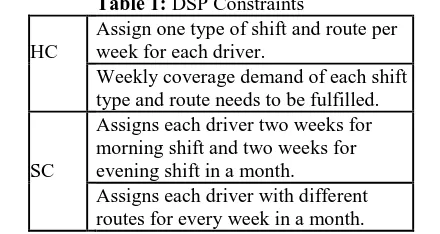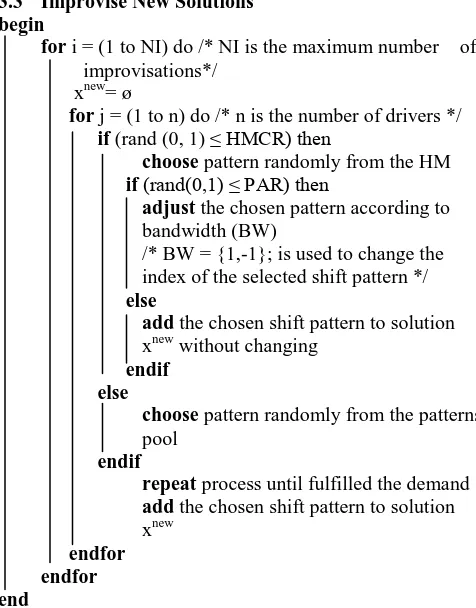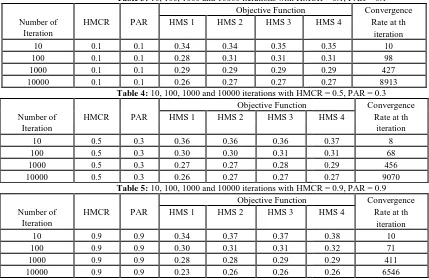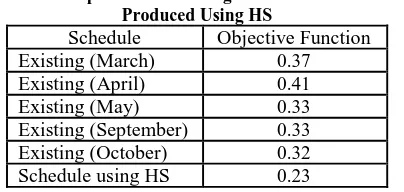I ter atio al Sy posiu o Resear h i I ovatio a d Sustai a ility ISoRIS ’ -16 October 2014, Malacca, Malaysia Sspecia; Issue
Sci.Int.(Lahore)26(5).1879-1882, 2014 ISSN 1013-5316; CODEN: SINTE 8 1879
OPTIMIZATION IN DRIVER’s SCHEDULING FOR UNIVERSITY
SHUTTLE BUS USING HARMONY SEARCH
Zatul Alwani Shaffiei1, Zuraida Abal Abas 2, Ahmad Fadzli Nizam Abdul Rahman2, Abdul Samad Shibghatullah2 and Burairah Hussin2
Optimization, Modelling, Analysis, Simulation and Scheduling (OptiMASS) Research Group Faculty of Information and Communication Technology,
Universiti Teknikal Malaysia Melaka (UTeM), Hang Tuah Jaya, 76100 Durian Tunggal, Melaka
Email: [email protected], {2zuraidaa, fadzli, samad, burairah}@utem.edu.my
ABSTRACT: This paper is about driver scheduling which is categorized as a difficult combinatorial problem. Driver scheduling is the process of assigning shift to the drivers based on hard and soft constraints. The proposed technique is Harmony Search, which is a recently developed population-based meta heuristic optimization algorithm. This study will be implemented to UTeM Shuttle Bus. The number of drivers involved is about 25. It is viewed that the objective function evaluated by Harmony Search is less than a manual solution. Therefore, the result produced for this project is quite promising since the objective function obtained is better than the real schedule which is done manually.
KEYWORDS: Driver’s Scheduling, Optimization, Harmony Search, Meta Heuristic
1.0 INTRODUCTION
Universiti Teknikal Malaysia Melaka (UTeM) is a university located in Melaka and it has three campuses spread within the locality of the state of Melaka. Further, since this university has yet to have a permanent hostel for students, students enrolled in the university stay in hostels outside the three campuses. In this situation, shuttle buses have been used to transport students from the hostels to the respective campuses so that they can attend classes, lectures and any activities in campus. At the university, the Departement of University Vehicle Management, known as the BPKU (its acronym in Malay language), is responsible to prepare the schedule of the shuttle bus to ensure that efficient transportation is provided for the students. It has been a common practice for this department to prepare the shuttle bus schedule every semester according to students’ timetable and placement. In planning the bus schedule, it is crucial to determine the duties, tasks or shifts of the drivers. Considering that BPKU prepare the schedule manually every month, it is difficult to plan an optimum and balanced schedule for the drivers. Hence, this study focuses on the problem of driver scheduling (DSP). There are various methods that have been proposed to solve driver (crew) scheduling problems. Lourenco et al. [1] brought a multi objective crew scheduling model, which was tackled using a tabu search technique, meta heuristics, and genetic algorithms. Valouxis and Housos [3] presented a quick search approach that used the main algorithm such as the cost matching, set partitioning and shortest path. Chen and Niu [2] proposed a tabu search algorithm to solve bus crew scheduling problem, which considers early day and late duty modes with time shift and work intensity constraints. While Chen and Li [4] and Dias et al. [5] used genetic algorithm in their research, Li and Kwan [6] used hybrid genetic algorithm, with fuzzy set theory as their research approach. Belen et al. [7] proposed two approaches to obtain solutions, which are the Grasp algorithm and Scatter Search algorithm. In this study, the proposed technique is Harmony Search, which is a recently developed population-based meta heuristic optimization algorithm by Geem et al. [8][9]. This paper is organized as follows: Section 2.0 defines the DSP
and Section 3.0 presents the proposed harmony search algorithm. This is followed by Section 4.0 that presents the results, and finally, concluding remarks are presented in Section 5.0.
2.0 DRIVER SCHEDULING PROBLEM (DSP) DSP can be defined as the process of assigning the shift to drivers based on two types of constraints which are the hard constraints (HC) and soft constraints (SC) as shown in Table 1. In creating the schedule, the hard constraints must be satisfied, but not all of the the soft constraints need to be satisfied. However, in order to produce a better and more optimum result than the existing schedule, the violation of soft constraints should be minimized [8]. There are three objectives of this study: To generate a driver schedule automatically using Harmony Search, to formulate DSP into mathematical equation and to compare the result with the existing schedule.
Table 1: DSP Constraints
HC
Assign one type of shift and route per week for each driver.
Weekly coverage demand of each shift type and route needs to be fulfilled.
SC
Assigns each driver two weeks for morning shift and two weeks for evening shift in a month.
Assigns each driver with different routes for every week in a month.
3.0 THE HARMONY SEARCH ALGORITHM FOR DSP
HSA is one of the meta heuristic methods that has been recently developed by Geem et al. It mimics the improvisation process of music players [10]. In music performance, each musician plays one musical note at a time. These musical notes are combined together to form a harmony, measured by aesthetic standards [11]. The procedure of HSA has the following five main steps with pseudo code:
3.1 Initialization of HSA parameters
I ter atio al Sy posiu o Resear h i I ovatio a d Sustai a ility ISoRIS ’ -16 October 2014, Malacca, Malaysia Sspecia; Issue
1880 ISSN 1013-5316; CODEN: SINTE 8 Sci.Int.(Lahore)26(5).1879-1882, 2014
consideration rate (accumulative search)), pitch adjustment rate (PAR, analogous to local search) and BW (bandwidth) is very important because these values will be used during the improvisation process to produce new values.
3.2 Initialize the Harmony Memory (HM) begin
for i = (1 to WEEK) do /* WEEK is the number of weeks */
for j = (1 to HMS) do xj = ø;
for k = (1 to n) do /* n is the number of drivers */
choose one pattern randomly for driver k based on demands
endfor
evaluate the soft constraints
calculate the objective function value f(xj) add xj to HM
endfor endfor end
Table 2: Combined Pattern of Route and Shift
Patterns Combination of Route and Shift
Demand (driver needed) 0 Route 1 Shift M 5 1 Route 1 Shift E 2 2 Route 2 Shift M 3 3 Route 2 Shift E 2 4 Route 3 Shift M 2 5 Route 3 Shift E 2 6 Route 4 Shift M 1 7 Route 4 Shift E 1 8 Route 5 Shift M 1 9 Route 6 Shift M 3 10 Route 7 Shift M 2 11 Route 7 Shift E 1
With reference to the pseudo code above, the patterns are randomly initialized based on demand as shown in Table 2. The drivers are assigned for each pattern. For example, five drivers (demand) are assigned to Pattern 0 and so on. The numbers of drivers assigned to these routes are based on the total number of students in each hostel and peak hours. It is called as demand. In this step, the objective function is calculated after the evaluations of soft constraints are made. The equations below show how the objective function is calculated. The mathematical formulation for DSP constraints is provided as below, i denotes a driver, j denotes a shift, k denotes a route, l denotes a week and x denotes a schedule solution:
HC1:
j
J
k
K
x
ijkl
1
;
i
I
,
l
L
(1)
Sci.Int.(Lahore),26(5),1879-1883,2014
HC2:
i
I
x
ijkl
d
jk;
l
L
where
d
jkis coverage demand of shift j and route k
(2) SC1:
j
J
l
L
x
ijkl
2
;
i
I
(3) SC2:
k
K
l
L
x
ijkl
1
;
i
I
(4) Based on the problem formulation for soft constraints, the objective function is formed, c denotes a soft constraint, fc denotes value to soft constraint c, fc(X) denotes value given by the soft constraint c applied to the solution X and mc denotes value given by the soft constraint c applied to the solution X. The goal is to find a solution for X that satisfies fc(X) > mc for every soft constraint c.
Minimize
c
c
C
(
x
)
f
(
X
)
c ijklsoft
subject to:Equation (1), (2), (3) and (4)
Equation 1 and 2 above refers to the mathematical equation of hard constraints, while equation 3 and 4 refers to mathematical equation of soft constraints. Therefore, to consider this objective function, equation 3 and 4 is closely related since the objective function is to minimize the soft constraint violation. From the objective function above, the summation is the overall value of soft constraint
c and
subtracted by 1 to get a value that approaches 0.
3.3 Improvise New Solutions begin
for i = (1 to NI) do /* NI is the maximum number of improvisations*/
xnew= ø
for j = (1 to n) do /* n is the number of drivers */ if (rand (0, 1) ≤ HMCR) then
choose pattern randomly from the HM if (rand(0,1) ≤ PAR) then
adjust the chosen pattern according to bandwidth (BW)
/* BW = {1,-1}; is used to change the index of the selected shift pattern */ else
add the chosen shift pattern to solution xnew without changing
endif else
choose pattern randomly from the patterns pool
endif
repeat process until fulfilled the demand add the chosen shift pattern to solution xnew
I ter atio al Sy posiu o Resear h i I ovatio a d Sustai a ility ISoRIS ’ -16 October 2014, Malacca, Malaysia Sspecia; Issue
Sci.Int.(Lahore)26(5).1879-1882, 2014 ISSN 1013-5316; CODEN: SINTE 8 1881
Table 3: 10, 100, 1000 and 10000 iterations with HMCR = 0.1, PAR = 0.1
Objective Function Convergence Number of HMCR PAR HMS 1 HMS 2 HMS 3 HMS 4 Rate at th
Iteration iteration
10 0.1 0.1 0.34 0.34 0.35 0.35 10
100 0.1 0.1 0.28 0.31 0.31 0.31 98
1000 0.1 0.1 0.29 0.29 0.29 0.29 427
10000 0.1 0.1 0.26 0.27 0.27 0.27 8913
Table 4: 10, 100, 1000 and 10000 iterations with HMCR = 0.5, PAR = 0.3
Objective Function Convergence Number of HMCR PAR HMS 1 HMS 2 HMS 3 HMS 4 Rate at th
Iteration iteration
10 0.5 0.3 0.36 0.36 0.36 0.37 8
100 0.5 0.3 0.30 0.30 0.31 0.31 68
1000 0.5 0.3 0.27 0.27 0.28 0.29 456
10000 0.5 0.3 0.26 0.27 0.27 0.27 9070
Table 5: 10, 100, 1000 and 10000 iterations with HMCR = 0.9, PAR = 0.9
Objective Function Convergence Number of HMCR PAR HMS 1 HMS 2 HMS 3 HMS 4 Rate at th
Iteration iteration
10 0.9 0.9 0.34 0.37 0.37 0.38 10
100 0.9 0.9 0.30 0.31 0.31 0.32 71
1000 0.9 0.9 0.28 0.28 0.29 0.29 411
10000 0.9 0.9 0.23 0.26 0.26 0.26 6546
The pseudo code above shows the algorithm for improvisation in HS. The new pattern and objective function will be compared with the existing objective function in HM. If the value of new objective function is less than the value of objective function in the existing HM, it will replace the worst one. The improvisation is based on HMCR, PAR and randomization. All of the new patterns produced for every week will be combined together to calculate the objective function. The improvisation for each driver will be iterated until it fulfills the demand for every week.
3.4 Update the HM begin
for i = (1 to HMS) do
find the highest value of objective function (the worst one) in HM
compare the objective function of NCHV xnew with the worst one xj
endfor if (xj > xnew)
replace xj with xnew else
remain xj in HM endif
sort HM in ascending order based on f(x) end
After NCHV is produced and new objective function is obtained, it will be compared to the objective function in the existing HM. If the new objective function is less than the objective function in the existing HM, the worst one in HM
will be eliminated and replaced with a new NCHV. However, if the new objective function is more than the objective function in the existing HM, there will be no replacement or elimination. Subsequently, the HM needs to be sorted in ascending order.
3.5 Check the Termination Criteria
Step 3 and 4 will be iterated until it reaches the termination criteria. In this project, the numbers of iteration set are 10, 100, 1000 and 10000 to see the difference between these changes iteration. However, if more iteration occurs, the result produced will be better.
4.0 RESULT
There are two comparisons made in this section. First, the comparison of result for different number of iteration, and second the comparison of the schedule produced using HS with the existing schedule.
4.1 Comparison Between Different Number of Iterations and Parameters
I ter atio al Sy posiu o Resear h i I ovatio a d Sustai a ility ISoRIS ’ -16 October 2014, Malacca, Malaysia Sspecia; Issue
1882 ISSN 1013-5316; CODEN: SINTE 8 Sci.Int.(Lahore)26(5).1879-1882, 2014
1000, at 427th iteration in Table 3, the objective function produced for each HMS starts to become static until the last iteration. From these three tables, it shows that with higher HMCR, the the faster the achievement of the convergence rate.
4.2 Comparison of Real Schedule and Schedule using HS
Table 6 below shows the comparison of result using HS and real schedule in UTeM. There are 5 real data that have been compared which are from March, April, May, September and October. The objective function gained for schedule using HS is 0.23. This is better than the objective function in real schedule, which are 0.32, 0.33, 0.33, 0.37 and 0.41. Even though the implementation of HS technique towards DSP is not really promising because of the result produced is still unachievable, the most optimum value, which is 0 still outperforms the objective function obtained from the real schedule. Therefore, it is clear that the HS technique has been successfully applied and it gives better result. Other advantage of using
HS technique is from the aspect of
time consuming.
Table 6: Comparison of Existing Schedule and Schedule Produced Using HS
Schedule Objective Function Existing (March) 0.37 Existing (April) 0.41 Existing (May) 0.33 Existing (September) 0.33 Existing (October) 0.32 Schedule using HS 0.23
5.0 CONCLUSION
This paper has proposed the harmony search algorithm for solving the driver scheduling problem. All of the objectives stated in Section 2.0 are achieved. A recently developed population-based meta heuristic optimization algorithm, HSA which is inspired by the improvisation process of musicians developed by Zong Woo Geem in 2001, seemed to be a quite promising technique in solving optimization problems since the results produced outperformed and produced better schedule than real schedule for DSP. For future works, hybridization with other techniques in this driver scheduling problem will be applied to get an excellent and better result.
ACKNOWLEDGEMENTS
This work was supported by research grants RAGS/2013/FTMK/ICT02/01/B00039 under Ministry of Education of Malaysia.
REFERENCES
[1] H. R. Lourenço, “Metaheuristics for The Bus-Driver
Scheduling Problem,” pp. 1–26, 2005.
[2] M. Chen and H. Niu, “A Model for Bus Crew
Scheduling Problem with Multiple Duty Types,”
Discrete Dynamics in Nature and Society, vol. 2012, pp. 1–11, 2012.
[3] C. Valouxis and E. Housos, “Combined bus and driver
scheduling,” vol. 29, no. January 2000,
2002.
[4] Q. Chen and C. Li, “An Approach to Bus-Driver
Scheduling Problem,” 2010 Second WRI Global Congress on Intelligent Systems, pp. 379–382, Dec. 2010.
[5] T. G. Dias, “A Genetic Algorithm for the Bus Driver
Scheduling Problem,” pp. 35–40, 2001.
[6] J. Li and R. S. K. Kwan, “A fuzzy genetic algorithm for
driver scheduling,” European Journal of Operational Research, vol. 147, no. 2, pp. 334–344, Jun. 2003. [7] M. Belén, V. García, B. B. Zanón, and E. C. Rodríguez,
“Combining Metaheuristic Algorithms to Solve a
Scheduling Problem,” 2012.
[8] M. A. Al-Betar, A. T. Khader, and M. Zaman,
“University Course Timetabling Using a
Hybrid Harmony Search Metaheuristic Algorithm,”
IEEE Transactions on Systems, Man, and Cybernetics, Part C (Applications and Reviews), vol. 42, no. 5, pp. 664–681, Sep. 2012.
[9] G. V. Loganathan, “A New Heuristic Optimization
Algorithm: Harmony Search,” Simulation, vol. 76, no. 2, pp. 60–68, Feb. 2001.
[10]R. Diao and Q. Shen, “Feature selection with harmony search.,” IEEE transactions on systems, man, and
cybernetics. Part B, Cybernetics : a publication of the
IEEE Systems, Man, and
Cybernetics Society, vol. 42, no. 6, pp. 1509–23, Dec. 2012.
[11]M. Hadwan, M. Ayob, N. R. Sabar, and R. Qu, “A
harmony search algorithm for nurse rostering



